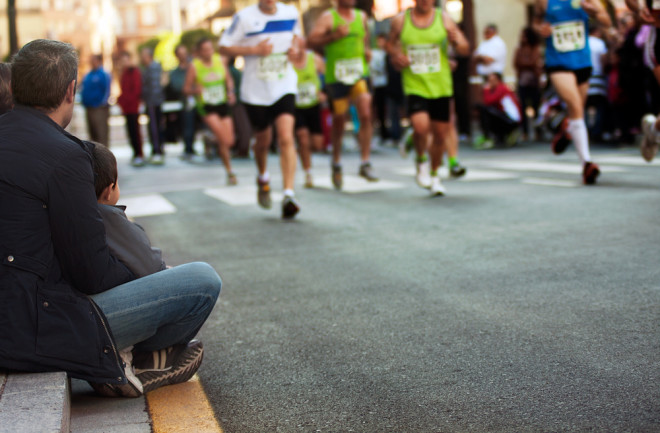Many runners know the feeling well — miles of training can feel sluggish and uninspiring. Then, on race day, the course is filled with other runners as well as spectators. The steps seem to come easier and faster.
Scientists have long understood that people can perform better on certain tasks when others are watching. But after COVID-19 hit, spectators disappeared from sidelines and stadiums. When events resumed without fans, scientists had an opportunity to further study the relationship between audiences and motivation, a concept called social facilitation.
Why Do People Act Differently When Watched?
The idea behind social facilitation is that having an audience motivates people to do better than they would if they were alone. Although clinical trials and data analysis into social facilitation have spanned more than a century, neuroscience studies involving social facilitation are new. These studies are helping to determine what happens in the brain when people look on and performance improves (or, in some cases, declines).
In a 2018 study in Social Cognitive and Affective Neuroscience, researchers wanted to see what was happening in the brain when a person knew others were watching them and their performance improved.
“We often think that being watched by people can be bad, that it will lead to worse performance. But I think that might not necessarily be the case,” says the study’s lead author, Vikram S. Chib, an associate professor of biomedical engineering at The Johns Hopkins University School of Medicine.
Chib and his research team recruited participants who agreed to perform a newly learned task while undergoing functional magnetic resonance imaging (fMRI). The task involved using a type of hand-held controller to move a target on a screen into a desired location. In some trials, the participants knew they would receive $25. In other trials, the participants knew they were being watched.
Read More: 5 Thought-Provoking Facts About Brain Function
The Psychological Incentives of Being Watched
When a participant was being watched, they were actually in the fMRI machine so they couldn’t see their spectators. But there was a screen inside the machine. Before the task began, participants saw a live feed of the observers off to the side, watching their every move.
Glimpsing the observers was enough to spark social facilitation. “In the context of this study, it seemed to improve performance,” Chib says.
In the imaging, researchers saw activity in the dorsomedial prefrontal cortex and the ventromedial prefrontal cortex, meaning the brain was processing being watched as a type of reward.
“It seems that social areas of the brain interact with value areas to motivate performance,” Chib says.
Visualizing Rewards
Rewards are motivating — whether it comes in the form of a $25 check or the sense that others are watching — and that can inspire performance.
For some people who are performing without an audience, Chib says future research could determine whether visualizing an audience could spark motivation.
“If you think about how those motivational influences of social incentives are processed, we might come up with better ways to do well in those situations,” he says.
Read More: Research Reveals Surprising Conversations Between Our Brain Cells
Psychologist Norman Triplett first introduced the concept of social facilitation, or the motivation to perform in front of others, in 1898.
Triplett analyzed data from cyclists who rode in races and compared their performance to when they raced alone against the clock and when they rode with a group that included a pacesetter. Triplett found the cyclists rode faster in the races or as part of a group than they did during a solo time trial.
After Triplett analyzed the cycling data, he conducted a clinical experiment to test if children performed better on a simple task if they were competing against another child. In his study, his little participants were tasked with turning fishing reels as fast as they could. The children repeated the task alone and then in competition with another participant.
Children turned their wheels faster and worked harder when they were in competition with another child, supporting Triplett’s hypothesis.
More than a century of research has taught scientists that social facilitation doesn’t apply in every scenario, and what motivates one person might not work for another.
A 2021 study in International Review of Sport and Exercise Psychology found that in the past 100 years, there have been 82 studies with more than 7,000 participants that measured social facilitation in movement-related tasks. These studies found that the type of task mattered, and while the presence of spectators inspires some performances, others are hindered.
In general, studies have found that conditioning activities (like running or skiing) are more likely to be better performed in the presence of others. Tasks involving coordination (i.e., shooting at a target) are more likely to be hindered when others are watching.
But when the recent global pandemic shut down stadiums, researchers found significant exceptions.
Read More: Are There Purposeless Behaviors?
A 2021 study in Psychology of Sport and Exercise looked at results from the World Cup biathlon that took place from November 2020 through March 2021 in Austria, Czech Republic, Finland, Germany, Italy, and Sweden.
In a biathlon, participants have both a conditioning activity (cross-country skiing) and a coordination activity (target shooting) which allowed the researchers to consider the two types of tasks without an audience present.
The researchers compared results with past World Cups when spectators had been present. They found that male participants did better on conditioning tasks (the ski portion) with an audience watching, but their performance deteriorated on the coordination task (target shooting).
In contrast, the female athletes skied worse when people were watching but shot better while an audience looked on. The study’s authors concluded that past research into social facilitation has not included enough female participants.
While there has been a century of research on this concept, there is still more to uncover.
Read More: How Failing Could Actually Help us Succeed

